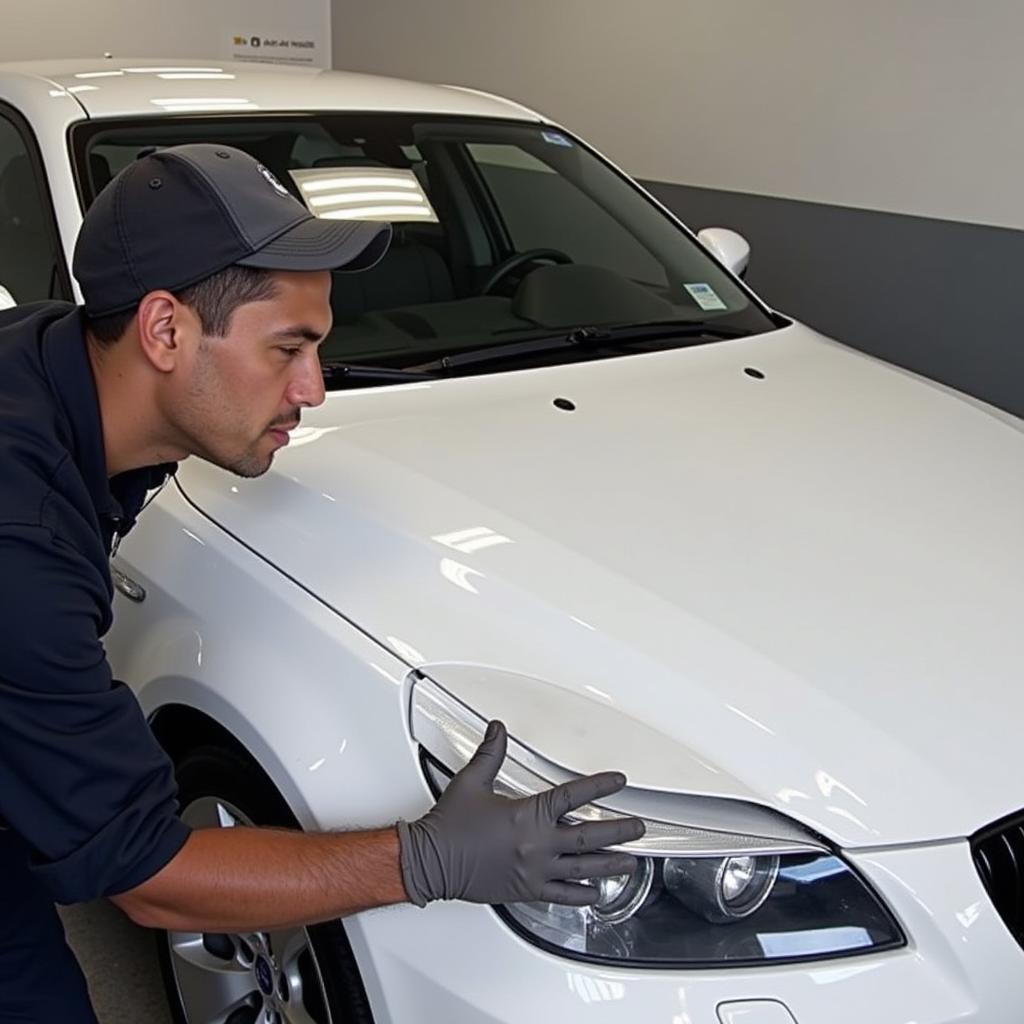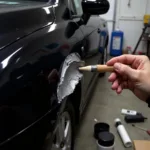Chipped paint on car repair is a common issue that car owners face. Whether it’s from a minor fender bender, a rogue shopping cart, or simply road debris, these unsightly chips can detract from your car’s appearance and potentially lead to rust. This comprehensive guide will delve into the causes, prevention, and various repair methods for chipped car paint, empowering you to restore your car’s finish.
Addressing minor paint chips quickly can prevent larger problems down the road, such as rust formation. This guide will explore DIY solutions, professional repair options, and how to choose the best approach for your specific situation. You’ll learn how to assess the damage, select the right materials, and execute the repair effectively. We’ll also discuss preventative measures to minimize future chipping.
For those interested in a more cost-effective approach to addressing minor chips, you might want to check out our guide on chipped paint on car repair cost.
Understanding Chipped Paint
What Causes Paint Chips?
Car paint chips occur when the paint’s protective layer is compromised, exposing the underlying metal. Several factors can contribute to this:
- Road Debris: Stones, gravel, and other debris kicked up by tires are the most frequent culprits.
- Minor Collisions: Even minor bumps and scrapes can chip the paint.
- Weather Conditions: Extreme temperatures, hail, and UV rays can weaken the paint over time.
- Poor Maintenance: Neglecting regular washing and waxing can make the paint more susceptible to chipping.
Why Repair Chipped Paint?
Beyond aesthetics, repairing chipped paint is crucial for preventing rust. Exposed metal is vulnerable to oxidation, which can lead to unsightly rust spots and potentially compromise the structural integrity of the car’s body.
DIY Chipped Paint Repair
How to Repair Minor Chips
Minor chips, often called “stone chips,” can be repaired at home with a touch-up paint pen or kit.
- Clean the Area: Thoroughly clean the chipped area with soap and water, then dry it completely.
- Apply Touch-Up Paint: Carefully apply the touch-up paint to the chip, using a fine-tipped brush or the pen applicator.
- Level the Paint: If necessary, use a toothpick or razor blade to carefully level the touch-up paint with the surrounding paint surface.
- Apply Clear Coat (Optional): For added protection, apply a thin layer of clear coat once the touch-up paint is dry.
If you’re looking for more detailed instructions on DIY repair, our guide on how to repair chipped paint on a car provides a step-by-step walkthrough.
Professional Chipped Paint Repair
When to Seek Professional Help
For larger chips, cracks, or areas where the damage extends beyond the clear coat, professional repair is recommended. Professional auto body shops have the expertise and equipment to match the paint color perfectly and achieve a seamless repair.
“For deeper chips or those that have already started to rust, professional repair is the best option to ensure long-term protection and a flawless finish,” says renowned auto body expert, Michael Stevens.
Repair Chipped Car Paint Milano Red Paint
If you own a car with a specialized color like Milano Red, finding the correct touch-up paint is crucial. You can learn more about repairing chipped Milano Red paint in our dedicated guide, repair chipped car paint milano red paint.
Preventing Chipped Paint
Protective Measures
Taking preventative measures can significantly reduce the risk of chipped paint:
- Regular Washing and Waxing: This creates a protective barrier against debris and environmental factors.
- Maintain a Safe Following Distance: This reduces the risk of being hit by debris from other vehicles.
- Park Carefully: Avoid parking in areas prone to door dings and other minor impacts.
“Protecting your car’s paint is an investment that pays off in the long run. Regular maintenance can prevent costly repairs and maintain your car’s value,” advises automotive paint specialist, Sarah Miller.
If your chipped paint is specifically on your car door, you might find this resource helpful: how to repair chipped paint on car door. Addressing the chip promptly, especially if rust is present, is key. For more information on rust repair, refer to our guide on repair chipped paint car rust.
 Applying paint protection film to a car
Applying paint protection film to a car
Conclusion
Chipped paint on car repair is a manageable issue, whether you choose a DIY approach or opt for professional help. Understanding the causes, prevention methods, and various repair options empowers you to make informed decisions and keep your car looking its best while protecting it from further damage. Addressing chipped paint promptly not only preserves your car’s appearance but also safeguards its value and prevents more extensive problems like rust.
FAQ
- How much does it cost to repair chipped car paint? The cost varies depending on the size and location of the chip, as well as the repair method.
- Can I repair chipped paint myself? Yes, minor chips can often be repaired with touch-up paint.
- How do I prevent chipped paint on my car? Regular washing, waxing, and maintaining a safe following distance can help prevent chips.
- What happens if I don’t repair chipped paint? Untreated chips can lead to rust, which can damage the car’s body.
- How do I choose the right touch-up paint? Consult your car’s owner manual or a reputable auto parts store.
- Can clear coat be applied over touch-up paint? Yes, clear coat can provide added protection and a smoother finish.
- How long does it take for touch-up paint to dry? Drying times vary, but it’s generally best to wait at least 24 hours before washing or waxing.
Need help with chipped paint repair or any other car diagnostics issue? Contact us via WhatsApp: +1(641)206-8880, Email: [email protected]. Our customer support team is available 24/7.

